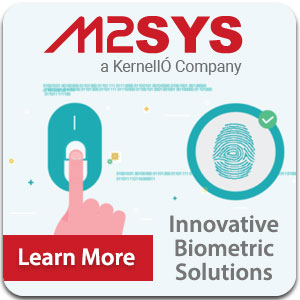Re-posted with permission from M2SYS and edited.
Biometric technology is a general term that refers to the use of technology to analyze and identify a person’s physiological and behavioral attributes. These attributes are unique to a particular individual; hence, they are effective parameters used in detection. Biometric technology obtains its data through two major categories: the physical and behavioral attributes related to the human body. Examples of physical biometrics that have been implemented include facial recognition, iris recognition and fingerprint recognition, while examples of behavioral biometrics include walking patterns, gestures and voice recognition.
Biometrics is an evolving and complex paragon of technologies. When these technologies are implemented wrongly, it usually leads to loopholes if not checked, and can be exploited as an avenue to encourage fraud. Therefore, it is imperative to understand the strengths, limitations and applications of biometrics technology if you intend to use these technologies to advance financial inclusion.
The 5 Things You Should Know
1. Fingerprint Biometrics Is a Widely Recognized Mode of Identification
Fingerprint biometrics is considered as one of the most matured biometric technologies and is an acceptable form of legitimate evidence in courts of law all over the world. Fingerprint biometrics are used routinely in the forensic divisions worldwide to investigate crimes. It is also used as a mode of security for online transactions. For example, biometric cryptocurrency cards protect bitcoin transactions with fingerprints.
The architecture of fingerprint-based biometrics is composed of four components: a user interface, a system database, an enrollment module and an authentication module. The user interface provides the pathway for a user to indicate his identity and input his fingerprint into the system. The system database comprises a collection of records, each of which corresponds to the authorized user that has been granted access to the system. The enrollment module has the function of enrolling persons and their fingerprints into the system database. Finally, the authentication module authenticates the identity of a person that intends to access the system.
Fingerprint biometric capture and authentication can be carried out on some of the most advanced laptops that have the specifications to support this technology. The best laptops for this technology are those with built-in fingerprint readers because they have been equipped with accurate fingerprint sensors. Some of these laptops include the Asus Vivobook F510U, the Acer Swift 3, and the Dell XPS 12 9630.
2. India’s Big Biometric Database Houses 1+ Billion Profiles
India is known for having the largest biometric database in the world. About 99% of Indian adults have given their biometric profiles to their government. The biometric database contains the faces, ten fingerprints and two iris scans of each of the 1.16 billion people in India. The database collection is a strategy to issue a distinct ID number for residents that will enable them to have access to services throughout the country.
3. Consumers Are Ready to Adopt Biometric Technology
Consumers have expressed their preference for biometric technology compared to the traditional verification methods in the US, China, India and the United Kingdom. Fingerprint scanning has just displaced PIN and password as the preferred method of mobile authentication among survey respondents. In fact, fingerprint scanning is now a mandatory form of authentication for the use of the biometric cryptocurrency card that hosts multiple popular cryptocurrencies.
Biometric technology aids secure transactions by eliminating the need for a password, making mobile account access fast and easy for credit union members. Consumers cited security and speed as the factors to consider when choosing how to access their devices, their apps and their data.
4. Mobile Biometrics Are Experiencing Exponential Growth
Mobile biometric technology is expected to explode at a compound annual growth rate of about 80% between the years 2019 to 2021. This prediction is based on the increasing deployment of the mobile fingerprint mode of recognition.
Fingerprint scanning is not the only source of biometric data that is expected to play a crucial role in the exponential growth of mobile user authentication. Voice and facial forms of recognition are poised to grow tremendously as well.
5. No Single Biometric Will Work for Everybody
A service that relies on biometric technology should not necessarily use just one kind of biometric. The type of biometrics used should suit its customer base. For instance, fingerprint mode of identification can be unreliable in cases where the people being registered for financial services are manual workers, those that live in a dusty environment, or are over 50 years in age. Voice mode of recognition can be difficult to use with mobile phones because mobile phones with low-quality builds have poor microphones that will not capture the full vocal range.
Furthermore, there is also some personal and cultural predispositions that can also pose a threat to the usability of some biometrics. A notable example is the use of iris biometrics which is disliked by most people because they are reasonably sensitive about their eyes. So, there should be various methods of biometric authentication available that can suit everyone. The approach undertaken in India using several different methods to confirm identity is quite appropriate to ensure universal usability.
Learn How Biometric Usage Can Help Your Organization
So how does this information impact your use of biometric technology at your school, company, hospital or agency? The ISG, with its partners like M2SYS, can provide a myriad of solutions to help you quickly and accurately identify and track students, patients, visitors, employees, and even inmates, inside your facilities. Biometric technologies can be used to grant physical access to buildings or sensitive rooms, as well as network access to your servers or remote access to important data.
From stand alone to mobile devices, we have the technology available today to help you improve your ID and tracking needs to grant proper access rights, verify accurate identification, and ensure appropriate services to the correct individuals.
Tell your local ISG expert about your specific identification and security needs, and consider how a biometric solution could be right for your organization.
Original article written by Leonardo Sam Waterson for M2SYS.


